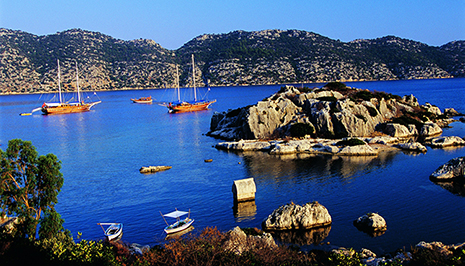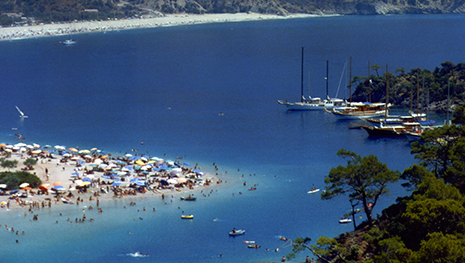Cruise Articles - Cruise Reviews :
Turkey - Lycia - Cruising the Islands

Lycia: Sailing Through the Centuries
by Peter Sommer
Lycia in southern Turkey is packed with some of the finest wonders of the world, with a coastline perfect for sailing. Today there is a whole raft of nautical charts and coastal pilots available for people cruising there.
Yet only 200 years ago this coast in the Eastern Mediterranean was a complete blank on the earth’s atlases. The man we have to thank for its transformation, for literally putting this part of Turkey on the map, is a celebrated figure in all things maritime. His name is an absolute constant on shipping forecasts and various instruments, for it became the scale on which all winds are rated: Beaufort.
Of course the coast of Lycia was well known and used long before Francis Beaufort, a British Admiral, began his survey in 1810. It was directly on one of the main shipping routes in antiquity, the way between Greece and Egypt and in Christian times on the pilgrim trail from Constantinople to Jerusalem. Anybody who was anybody in ancient times seems to have sailed along its coast or changed ships there – from Anthony and Cleopatra to St. Paul, Brutus to Hadrian.
Yet these sailors are relatively recent compared with those who were travelling on one of the greatest archaeological discoveries ever made. The world’s oldest shipwreck lies off the Lycian shore, revealing the extraordinary length of time that people have been navigating along this coast. When the Ülü Burun wreck was dated to 1,350 BC, it sent shockwaves through maritime history. Here was a 3,350 year old vessel – a time capsule from the Bronze Age – and no ordinary little boat at that, but one carrying an extraordinary cargo that gives some idea of the sophisticated trade going on here in the dim and distant past. Aboard were tons of copper, ingots of glass and lapis lazuli, pellets of purple dye, swords and tridents, a wax book, and even a musical instrument similar to a lyre, probably used by the crew to entertain themselves of an evening. A golden scarab of the Egyptian queen Nefertiti is a clue as to the ship’s possible origin.
Today travellers can cruise in comfort unimaginable in the Bronze Age or even Beaufort’s time. The very best way to see the Lycian shore is aboard a gulet. The word probably derives from the French goulette, or schooner. For generations these two-masted wooden vessels, sometimes also known as caiques, have been used for transport and fishing along the southern coasts of Turkey. Typically designed with a sharp bow, broad beam and rounded aft, they are now designed and fitted with comfort, not trade in mind. Hand crafted in Turkey they come fully crewed, with a captain, cook, and additional deck hands. All passengers have to do is lie back, gaze at the horizon, and relax.

Photo: Lycia - courtesy Turkish Culture and Tourism Office
Much of the Lycian coast remains completely unspoilt. Soaring limestone mountains drop sheer into azure seas, carving the shore into a cavalcade of tiny coves, hidden bays, and pristine beaches. Hillsides are swathed in pine and olives trees. The ruins of countless ancient cities, Greek, Roman, and Byzantine cram the coast, limiting development to a few isolated areas. It’s the incredible combination of historical wonders, sailing, and superb swimming that make this coastline a truly magical destination.
Back in 1952, Freya Stark, one of the greatest women travellers of the 20th century, sailed along this shore and fell madly in love with it:
‘Every bay or headland of these shores, every mountain top round whose classic name the legends and clouds are floating, carries visible and invisible signs of its past .… There are not so many places left where magic reigns without interruption .… and of all those I know, the coast of Lycia is the most magical.’
Where the native Lycians came from and when is shrouded in the mists of time, but the civilisation they developed is utterly unique. Set between the Persian Empire to the east, and the ancient Greeks to the west, they borrowed ideas from both, fusing them into an exceptional architectural style, best seen in the tombs they’ve left behind. There are giant monolithic pillars crowned with grave chambers made of marble dating back some 2,500 years. Hewn out of cliff faces are gigantic tombs fashioned to look like Greek temples. Other burials were fashioned from the living rock to look like houses, complete with roof timbers, exactly like the wooden grain stores used in the surrounding countryside to this very day.
Most common are the Gothic looking sarcophagi, thousands of them still litter the region, some decorated with the head of Medusa or ferocious lions to ward off tomb robbers. The lids of these sarcophagi curve up to a narrow point, which if you look at them upside down, appear like a ship’s hull and keel, a significant motif for such a seafaring people.
Many of the greatest Lycian sites are directly accessible from the coast. Cast off after breakfast from Göçek, one of the main yachting centres in the region, and within a couple of hours you can have travelled back 1,400 years. Moor up at Gemiler island, less than a kilometre in length, and you’ll be able to explore the remains of a small Christian community from Byzantine times that’s been surveyed by Japanese archaeologists over the past two decades. Clinging to the island’s slopes are no less than five churches, littered with geometric mosaics and fallen columns carved with crosses.
The northern shore is packed with houses and shops equipped with cisterns where rainwater was collected and probably sold on for a tidy sum to passing shipping. Climb up through the trees and you’ll find an ancient processional way used by pilgrims en route to the cathedral church on the island’s peak. Time your visit correctly and you’ll reach the top ready to experience one of the very finest sunsets imaginable: the sea sparkling with gold as ranges of craggy hills turn into shimmering silhouettes.
Just inland from Gemiler lies Kaya Koy, a place brimming with atmosphere and mystery, the setting for Louis de Berniere’s novel. This is a genuine ghost town, abandoned by its Greek inhabitants when Turkey and Greece swapped populations in 1923. It’s not very old by the standards of other ruined towns along the coast, but wandering along its empty streets past crumbling houses and chapels is both pleasurable and inspiring, and makes you realise quite how well the truly ancient sites have survived.
Back on the gulet, life is like one long list of heavenly pleasures: a morning dip into the warm turquoise waters; a spot of snorkeling beside the rocky shore; an adventurous turn on the windsurfer as a breeze comes up; a short expedition in the kayak to scout out a hidden inlet. Needless to say if you want to conserve your energy, there are relaxation opportunities galore, from reading and sunbathing to a full blown snooze.
Then there’s the parade of tasty treats sent out from the galley, a real cornucopia of freshly prepared mezes and main dishes; stuffed eggplants, grilled lamb, multicoloured olives, spicy meatballs, feta cheese, and a whole host of salads tossed with local lemons and olive oil. On top of that is the bounty of fresh seasonal fruit: from mulberries to melons, pomegranates to strawberries. Turkey is a gastronome’s paradise and the ship’s cook never fails to conjure up mouthwatering sensations each and every day.
As you set sail from another languid lunch stop and the boat’s captain checks his position on the GPS, spare a thought for Captain Beaufort cruising along this coast at the start of the 19th century. He complained in his diary how little he had to go on to find his way: “the only accounts extant were those left by the ancient geographers…there was no nautical description of the coast, nor any charts whatever by which the mariner could steer”
His task was utterly painstaking. Dragging a 100 yard long steel chain marked with flags and poles on the shore, they took meticulous sightings and sextant angles, and plotted the resulting position points. Slowly but surely his team of surveyors worked their way along the coast, putting Lycia on the map, despite the heat and overgrown vegetation:
“their shoes cut on the rocks, soaked by the quagmires, or burned in the red hot sands were of but little use’
One of the prettiest places along the whole coast is Üçağız, which means ‘three mouths’. This tiny fishing village is connected to the interior by a thin rutted road that twists tortuously through a wild landscape of knife edge rocks. Not surprisingly the village is there because of the sea. It’s beautifully protected by two giant spits of land as well as the long thin mass of Kekova Island which forms a natural breakwater.
This has been a vital harbourage for some 2,500 years, and its history lies all about. On one side is an incredible necropolis (literally ‘city of the dead’) of stone sarcophagi standing up to ten foot tall and dating back to the 5th century before Christ; on the other; the storage buildings, churches, and houses of the Byzantine town a 1,000 years later. The modern village of Üçağız is tiny compared to its predecessors. Here you can find a few small places to stay; a couple of shops selling food and carpets, a tiny mosque, some restaurants and a bar. That’s it. It’s a perfect place to moor up and idle away a couple of days.
Sail east and the Taurus Mountains suddenly recede from the shore revealing a large fertile plain at Finike, which is the source of many of Turkey’s oranges. A glorious hour’s drive inland rises up and up to the ancient site of Arykanda. Set high on the side of a mountain this Greek and then Roman town literally has it all. It’s been dubbed the ‘Turkish Delphi’ because of its spectacular location and excellent preservation, but unlike the site in Greece you’re more than likely to be the only visitors there. There are all the usual trappings of a prosperous antique city – agora, stadium, temples, baths - but the setting makes it truly stand out. The view from the top of the theatre down a steep sided valley to the distant mountains is simply heart-stopping.
There is more to Lycia than sailing and archaeology. One of the great highlights of the region now is the Lycian Way, Turkey’s first long distance footpath. Rated by the UK’s Sunday Times as one of the ten best walks in the world, the trail follows 500 km of ancient tracks and mule roads that linked the region before the coming of the car. Waymarked with red and white stripes, many sections of it follow the coast, so it’s perfectly possible to drop anchor and venture off for a gentle stroll or serious hike. Some gulet operators now offer specialist walking cruises, so you can trek along some of the very best stretches of the Lycian Way, with a boat ever present offshore, providing luxurious transport, dining and accommodation. What could be finer than walking along a Roman road or shepherd’s track, discovering remote ancient cities with breathtaking vistas, and then having a swim off the gulet at the end of the day?
In many parts of Lycia you can head a short distance inland and step back in time to a simpler, pre-industrial age – to a countryside worked much as it would have been in America and Europe a few centuries back. Go in the right month and you’ll find women in colourful trousers sickling down golden wheat grown on slender hill terraces. Walk along dirt roads and you’ll hear the tinkle of goat bells filling the air, with a goatherd ushering on his flock of shiny black charges. Very occasionally you might even come across some semi-nomadic charcoal burners arriving into harbour with the fruits of their labours after several months living and working in the forests.
It’s the timeless quality of Lycia that is one of its greatest attractions. Although a lot has changed since Francis Beaufort first mapped the coast and many of its ancient cities, there’s a great deal that he would recognise today. His survey revealed a magnificent coastline and an untapped wealth of archaeological wonders. It wasn’t long before a whole army of European treasure hunters were out looking for the best ruins to ship home. When the first consignment of Lycian ‘marbles’ – statues, temples, and tombs – arrived at the British Museum in London they caused such interest and excitement among the public that there was a Gothic architectural revival. Fortunately there’s a vast amount left to be seen in Lycia, and more and more is being uncovered by archaeologists every year. These ancient sites form a perfect backdrop to a splendid sailing vacation. In many cases it’s possible to sail directly into the ancient harbour of a Lycian city and moor for the night. How much better can cruising get? Sailing the Lycian Shore really is the experience of a lifetime.

Peter Sommer runs a specialist travel company, Peter Sommer Travels, offering cultural tours and gulet cruises in Turkey, Greece and Italy as well as private gulet charters for groups from 2-24 people. In 1994 he walked 2,000 miles retracing Alexander the Great’s route across Turkey and fell in love with the country, its ancient civilisations, and its people. An archaeologist and documentary producer he has worked on many acclaimed BBC TV series including In the footsteps of Alexander the Great, and Tales from the Green Valley. He personally leads a number of guided Turkey tours each year.
You can find out more at www.petersommer.com